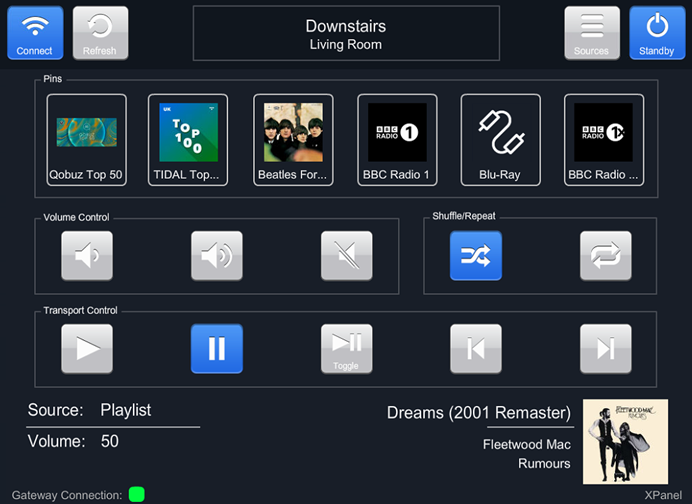Crestron/Linn Lite Crestron Driver for SIMPL Windows
Linn Lite Crestron Driver for SIMPL Windows
- This option offers control for basic functionally of Linn DS/DSM devices for Crestron systems using a 3-Series Processor. The Crestron project designed using SIMPL Windows can have up to 8 control points and within each control point a Linn DS/DSM device can be selected as the active room. The Linn Kustom DSM can be included as part of this setup and allows for several rooms to be added to the house with their own separate audio sources. This will work alongside Linn’s own control point application, Linn App, and changes will be communicated to the Crestron system.

- Requirements
-
- A Crestron 3-Series Processor*
- Linn DS/DSM devices (up to 20 rooms are possible)
- The Linn CI Gateway running on the local network – see here for information.
-
- Features
-
- Automatic discovery of a CI Gateway instance on the local network
- Room selection - each Crestron control point has an actively selected room within the house topology that can be changed via the control point itself.
- Grouping - the current grouping of rooms set via the Linn App will be reflected in the room selection menu and automatically update whenever a change in grouping occurs. The standby states and volumes of listening rooms can be set individually.
- For each room in the topology, the user has control over the following DS functionalities:
- Standby control - each room can be individually toggled between standby states.
- Volume control - step up/down, set absolute, mute toggle.
- Toggle shuffle and repeat states for appropriate sources.
- Transport control over any active playlist - play, pause, play/pause toggle, skip previous, skip next.
- Source selection - capable of selecting any visible external source.
- Metadata - retrieves basic metadata for currently playing item, including artwork.
- Pin selection - as on physical Linn DSM devices, 6 customizable buttons can be set up using the Linn App to provide easy access to a favourite radio station, playlist, or external source.
- Pin metadata - the name and associated artwork for each pin can also be accessed via the module and displayed on a Crestron control point interface.
- Standby states of all rooms within the house can be changed quickly and directly from a room selection menu without having to select the room as the active room of a CCP first
- Through SIMPL Windows configuration, a Crestron control point can be set to lock onto a certain room if that room is found through the CI Gateway
- For more advanced macro functionality, a command serial input optionally allows programmers to run LPEC commands directly to devices in the house from the Crestron processor.
-
Demo
- The driver is given alongside a demo that showcases the abilities. A video demonstration of the driver being used is shown in the following video:
- (Crestron Linn Lite Driver video demonstration)
- If you wish to try it for yourself then this setup guide outlines all the steps required to get a demo running where the functionality of the Linn Lite driver can be trialled.
- (download link for basic setup guide)
Installation Guide
- This guide gives extensive details about the operation of the driver and descriptions of all the signals available. This aims to assist in the integration of the driver into a larger customer project alongside other home automation features.
- (download link for full installation guide)
Download
- (download link for Linn Lite driver 1.0.6 demo project)
- CI Gateway requirements
-
- For CI Gateway running on Linn DSM – Requires firmware Davaar 99 or higher.
- For CI Gateway running using Kazoo Server – Requires Kazoo Server 4.11.27 or higher.
- Note: this driver will also run on Crestron 4-Series processors, but it if this hardware is available then it is highly recommended to use the Linn Crestron 4-Series Driver for SIMPL Windows. If you wish to keep the implementation simple, then add-on modules can be removed.